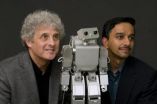(Press-News.org) A gene's location on a chromosome plays a significant role in shaping how an organism's traits vary and evolve, according to findings by genome biologists at New York University's Center for Genomic and Systems Biology and Princeton University's Lewis-Sigler Institute for Integrative Genomics. Their research, which appears in the latest issue of the journal Science, suggests that evolution is less a function of what a physical trait is and more a result of where the genes that affect that trait reside in the genome.
Physical traits found in nature, such as height or eye color, vary genetically among individuals. While these traits may differ significantly across a population, only a few processes can explain what causes this variation—namely, mutation, natural selection, and chance.
In the Science study, the NYU and Princeton researchers sought to understand, in greater detail, why traits differ in their amount of variation. But they also wanted to determine the parts of the genome that vary and how this affects expression of these physical traits. To do this, they analyzed the genome of the worm Caenorhabditis elegans (C. elegans). C. elegans is the first animal species whose genome was completely sequenced. It is therefore a model organism for studying genetics. In their analysis, the researchers measured approximately 16,000 traits in C. elegans. The traits were measures of how actively each gene was being expressed in the worms' cells.
The researchers began by asking if some traits were more likely than others to be susceptible to mutation, with some physical features thus more likely than others to vary. Different levels of mutation indeed explained some of their results. Their findings also revealed significant differences in the range of variation due to natural selection—those traits that are vital to the health of the organism, such as the activity of genes required for the embryo to develop, were much less likely to vary than were those of less significance to its survival, such as the activity of genes required to smell specific odors.
However, these results left most of the pattern of variation in physical traits unexplained—some important factor was missing.
To search for the missing explanation, the researchers considered the make-up of C. elegans' chromosomes—specifically, where along its chromosomes its various genes resided.
Chromosomes hold thousands of genes, with some situated in the middle of their linear structure and others at either end. In their analysis, the NYU and Princeton researchers found that genes located in the middle of a chromosome were less likely to contribute to genetic variation of traits than were genes found at the ends. In other words, a gene's location on a chromosome influenced the range of physical differences among different traits.
The biologists also considered why location was a factor in the variation of physical traits. Using a mathematical model, they were able to show that genes located near lots of other genes are evolutionarily tied to their genomic neighbors. Specifically, natural selection, in which variation among vital genes is eliminated, also removes the differences in neighboring genes, regardless of their significance. In C. elegans, genes in the centers of chromosomes are tied to more neighbors than are genes near the ends of the chromosomes. As a result, the genes in the center are less able to harbor genetic variation.
###
The research was conducted by Matthew V. Rockman, an assistant professor at New York University's Department of Biology and Center for Genomics and Systems Biology as well as Sonja S. Skrovanek and Leonid Kruglyak, researchers at Princeton University's Lewis-Sigler Institute for Integrative Genomics, Department of Ecology and Evolutionary Biology, and Howard Hughes Medical Institute.
The study was supported by grants from the National Institutes of Health.
END
Discovery of a molecular switch that turns off the natural process of skin pigmentation may lead to a novel way of protecting the skin – activating the tanning process without exposure to cancer-causing UV radiation. In their report in the journal Genes & Development, researchers from the Massachusetts General Hospital (MGH) Cutaneous Biology Research Center (CBRC) describe how blocking the action of this switch – an enzyme called PDE-4D3 – in the skin of mice led to a significant increase in melanin production.
"The primary goal of inducing melanin production in human ...
AUDIO:
When a person has a heart attack, and the heart stops beating, a new study led by researchers at Washington University School of Medicine in St. Louis suggests that the...
Click here for more information.
Heart attack patients whose hearts have stopped beating and who receive cardiopulmonary resuscitation (CPR) from bystanders fare better if their resuscitators skip the rescue breaths and do only chest compression, according to a study led by researchers at Washington ...
Size matters when it comes to the nucleus of a cell, and now scientists have discovered the signals that control how big the nucleus gets.
Nuclear size varies not only among different species, but also in different types of cells in the same species and at different times during development. In addition, cancer cells are known to develop larger nuclei as they become more malignant. Screening for cervical cancer, for example, involves looking for grossly distorted nuclei in cervical cells collected during a Pap smear.
"Pathologists look at nuclear size in cancer cells ...
Atmospheric fine particles affect the Earth's radiation balance by interacting with solar radiation and by participating in cloud formation. Biogenic volatile organic compounds are key players in new particle formation processes. Hence, terrestrial vegetation has an important role as the newly formed particles cool our climate. The chemical composition of such secondary organic aerosol (SOA) particles formed from volatile compounds emitted by vegetation is very complicated and only limited information on the phase state of SOA particles has been available. Thus the scientific ...
Des Moines, Iowa USA: World renowned scientists speaking at the World Food Prize Borlaug Dialogue have called for a radical transformation in the agriculture sector to cope with climate change, food security and to transition towards sustainability.
Dr Dennis Garrity, Director General of the World Agroforestry Centre and Professor MS Swaminathan, 1987 World Food Prize Laureate and founder of the MS Swaminathan Research Foundation, have teamed up to promote what they call a 'fresh out of the box solution' which is already dramatically improving crop yields while storing ...
Babies are curious about nearly everything, and they're especially interested in what their adult companions are doing. Touch your tummy, they'll touch their own tummies. Wave your hands in the air, they'll wave their own hands. Turn your head to look at a toy, they'll follow your eyes to see what's so exciting.
Curiosity drives their learning. At 18 months old, babies are intensely curious about what makes humans tick. A team of University of Washington researchers is studying how infants tell which entities are "psychological agents" that can think and feel.
Research ...
While the blood-brain barrier (BBB) protects the brain from harmful chemicals occurring naturally in the blood, it also obstructs the transport of drugs to the brain. In an article in Nature scientists at the Swedish medical university Karolinska Institutet now present a potential solution to the problem. The key to the BBB is a cell-type in the blood vessel walls called pericytes, and the researchers hope that their findings will one day contribute to new therapies for diseases like Alzheimer's and stroke.
"Our new results show that the blood-brain barrier is regulated ...
Many overseas nurses have negative experiences of living and working in the UK, particularly when it comes to feeling personally valued and professionally respected, according to the October issue of the Journal of Clinical Nursing.
Researchers from the University of Northampton also found that discrimination and racism still exist in the National Health Service and that the reality of first-world UK nursing is often very different to what overseas nurses expect.
Senior lecturer and nurse Julia Nichols and Professor of Neurophysiology Jackie Campbell carried out ...
Scientists at the University of Leeds have perfected a new technique that allows them to make molecular nanowires out of thin strips of ring-shaped molecules known as discotic liquid crystals (DLCs).
The findings could be an important step in the development of next generation electronic devices, such as light-harvesting cells and low-cost biosensors that could be used to test water quality in developing countries.
DLCs are disk-shaped molecules that are one of the more promising candidates for organic electronic devices. However, controlling their alignment has proved ...
Disorganised and emotionally unstable, poorly adapted, suffering from alcohol problems, impulsive, or with a "globally adapted" personality. These are the features of the four diagnosed types of compulsive gamblers identified by researchers at the University Hospital of Bellvitge (IDIBELL) and the Autonomous University of Barcelona (UAB). According to the scientific team, only one of these four shows signs of a significant pathology.
"We need to use different treatments for each sub-group of pathological gamblers in order to respond to their specific therapeutic difficulties ...



